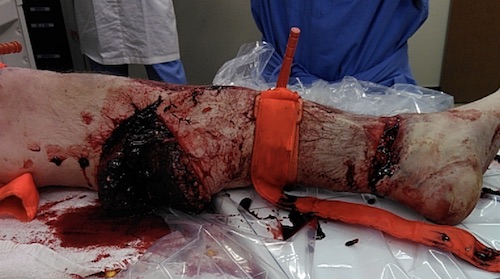Trauma: Mangled Extremity
Mangled Extremity
Definition
- Definition: Damage to ≥ 3 Functional Components
- Functional Components:
- Soft Tissue
- Nerves
- Vessels
- Bones
Mangled Extremity Severity Score (MESS)
- Factors:
- Tissue Injury:
- 1 – Low Energy (Stab, Simple Fracture or Pistol Gun Shot Wound)
- 2 – Medium Energy (Open Fracture, Multiple Fractures or Dislocation)
- 3 – High Energy (High-Speed MVC or Rifle Gun Shot Wound)
- 4 – Very High Energy (High Energy & Gross Contamination)
- Ischemia Time:
- 1 – Pulse Reduced or Absent but Perfusion Normal
- 2 – Pulseless, Paresthesia, Diminished Capillary Refill
- 3 – Cool, Paralyzed, Insensate, Numb
- Shock:
- 0 – SBP Always > 90 mmHg
- 1 – SBP Transiently < 90 mmHg
- 2 – SBP Persistently < 90 mmHg
- Age (Years):
- 0 – < 30
- 1 – 30-50
- 2 – > 50
- *Score Doubled if Ischemia Time > 6 Hours
- Tissue Injury:
- Used to Consider Amputation vs Salvage
- Score 0-6 Points – Limb Will Likely Be Salvaged
- Score 7-14 Points – Amputation Will Likely Be Required

Mangled Extremity
Treatment
- Salvage vs Amputation: Overall Functional Outcomes & Quality of Life Equivalent
- Formal Amputation Indications:
- Inadequate Physiologic Reserve from Other Injury
- Contributing to Significant Physiologic Derangement
- Traumatic with Destruction of Distal Tissues
- No Reasonable Expectation of Functional Recovery
- Guillotine Amputation Indications:
- Gross Contamination and Multiple Other Life-Threatening Injuries
Compartment Syndrome
Vascular Injury
Rhabdomyolysis